A Two-Way Nesting Unstructured Quadrilateral Grid, Finite-Differencing, Estuarine and Coastal Ocean Model with High-Order Interpolation Schemes
Abstract
1. Introduction
2. The Grid-Nesting Model
2.1. Basic Model Characteristics
2.2. Implementation of Nesting
- Step the CRG model forward to the next time step.
- Interpolate the HRG boundary conditions from the CRG model values both spatially and temporally. The time refinement and spatial refinement usually share the same ratio.
- Step the HRG model forward to the same physical time as the CRG model.
- Update the values of the overlapped CRG points with the new HRG model values.
2.3. Embedding Techniques
2.3.1. Update Schemes
- Directly-replacing (DR) scheme
- 2.
- Inverse distance weighting interpolation (IDWI) scheme
- Area-averaging (AVE) scheme
- 2.
- 9-point Shapiro filtering (SF) scheme
- 3.
- Full-weighting operator (FWO) scheme
2.3.2. Interpolation Schemes
- Zeroth-order uniform interpolation (UNI) scheme
- 2.
- Inverse distance weighting interpolation (IDWI) scheme
- 3.
- Inverse bilinear interpolation (IBI) scheme
- 4.
- Quadratic interpolation (QI) scheme
- 5.
- HSIMT parabolic interpolation (HPI) scheme
- 6.
- Upwind advection-equivalent interpolation (AEI) scheme
- 7.
- HSIMT advection-equivalent interpolation scheme
2.3.3. Conservation
3. Ideal Salinity Advection Experiment
3.1. Experiment Design
3.2. Results and Discussion
4. Validation and Assessment
4.1. Observational Data
4.2. Model Configuration & Experiments
4.3. Validation and Interpolation Scheme Assessment
4.4. Discussion
5. Conclusions
Author Contributions
Funding
Institutional Review Board Statement
Informed Consent Statement
Data Availability Statement
Acknowledgments
Conflicts of Interest
References
- Fix, G.J. Finite element models for ocean circulation problems. SIAM J. Appl. Math. 1975, 29, 371–387. [Google Scholar] [CrossRef]
- Luettich, R.A.; Westerink, J.J.; Scheffner, N.W. ADCIRC: An Advanced Three-Dimensional Circulation Model for Shelves, Coasts, and Estuaries. In Report 1. Theory and Methodology of ADCIRC-2DDI and ADCIRC-3DL; 1992. [Google Scholar]
- Westerink, J.J.; Luettich, R.A.; Blain, C.A.; Scheffner, N.W. ADCIRC: An Advanced Three-Dimensional Circulation Model for Shelves, Coasts, and Estuaries. In Report 2. User’s Manual for ADCIRC-2DDI; 1994. [Google Scholar]
- Lynch, D.R.; Ip, J.T.C.; Naimie, C.E.; Werner, F.E. Comprehensive coastal circulation model with application to the Gulf of Maine. Cont. Shelf Res. 1996, 16, 875–906. [Google Scholar] [CrossRef]
- Casulli, V.; Walters, R.A. An unstructured grid, three-dimensional model based on the shallow water equations. Int. J. Numer. Methods Fluids 2000, 32, 331–348. [Google Scholar] [CrossRef]
- Hervouet, J.M. TELEMAC modelling system: An overview. Hydrol. Process. 2000, 14, 2209–2210. [Google Scholar] [CrossRef]
- Hervouet, J.M. Hydrodynamics of Free Surface Flows: Modelling with the Finite Element Method; Wiley: Hoboken, NJ, USA, 2007. [Google Scholar]
- Chen, C.; Liu, H.; Beardsley, R.C. An Unstructured Grid, Finite-Volume, Three-Dimensional, Primitive Equations Ocean Model: Application to Coastal Ocean and Estuaries. J. Atmos. Ocean. Technol. 2003, 20, 159–186. [Google Scholar] [CrossRef]
- Danilov, S.; Kivman, G.; Schroter, J. A finite-element ocean model: Principles and evaluation. Ocean Model. 2004, 6, 125–150. [Google Scholar] [CrossRef]
- Wang, Q.; Danilov, S.; Schroter, J. Finite element ocean circulation model based on triangular prismatic elements, with application in studying the effect of topography representation. J. Geophys. Res. Ocean. 2008, 113. [Google Scholar] [CrossRef]
- Ford, R.; Pain, C.C.; Piggott, M.D.; Goddard, A.J.H.; de Oliveira, C.R.E.; Umpleby, A.P. A nonhydrostatic finite-element model for three-dimensional stratified oceanic flows. Part I: Model formulation. Mon. Weather Rev. 2004, 132, 2816–2831. [Google Scholar] [CrossRef]
- Ford, R.; Pain, C.C.; Piggott, M.D.; Goddard, A.J.H.; de Oliveira, C.R.E.; Umpleby, A.P. A nonhydrostatic finite-element model for three-dimensional stratified oceanic flows. Part II: Model validation. Mon. Weather Rev. 2004, 132, 2832–2844. [Google Scholar] [CrossRef]
- Piggott, M.D.; Pain, C.C.; Gorman, G.J.; Marshall, D.P.; Killworth, P.D. Unstructured adaptive meshes for ocean modeling. Geoph. Monog. Ser. 2008, 177, 383–408. [Google Scholar] [CrossRef]
- Karna, T.; Legat, V.; Deleersnijder, E. A baroclinic discontinuous Galerkin finite element model for coastal flows. Ocean Model 2013, 61, 1–20. [Google Scholar] [CrossRef]
- Blaise, S.; Comblen, R.; Legat, V.; Remacle, J.F.; Deleersnijder, E.; Lambrechts, J. A discontinuous finite element baroclinic marine model on unstructured prismatic meshes Part I: Space discretization. Ocean Dynam. 2010, 60, 1371–1393. [Google Scholar] [CrossRef]
- Comblen, R.; Blaise, S.; Legat, V.; Remacle, J.F.; Deleersnijder, E.; Lambrechts, J. A discontinuous finite element baroclinic marine model on unstructured prismatic meshes Part II: Implicit/explicit time discretization. Ocean Dynam. 2010, 60, 1395–1414. [Google Scholar] [CrossRef]
- White, L.; Deleersnijder, E.; Legat, V. A three-dimensional unstructured mesh finite element shallow-water model, with application to the flows around an island and in a wind-driven, elongated basin. Ocean Model. 2008, 22, 26–47. [Google Scholar] [CrossRef]
- Pietrzak, J.; Jakobson, J.B.; Burchard, H.; Vested, H.J.; Petersen, O. A three-dimensional hydrostatic model for coastal and ocean modelling using a generalised topography following co-ordinate system. Ocean Model. 2002, 4, 173–205. [Google Scholar] [CrossRef]
- Fringer, O.B.; Gerritsen, M.; Street, R.L. An unstructured-grid, finite-volume, nonhydrostatic, parallel coastal ocean simulator. Ocean Model. 2006, 14, 139–173. [Google Scholar] [CrossRef]
- Zhang, Y.L.J.; Ye, F.; Stanev, E.V.; Grashorn, S. Seamless cross-scale modeling with SCHISM. Ocean Model. 2016, 102, 64–81. [Google Scholar] [CrossRef]
- Hsu, L.-H.; Tseng, L.-S.; Hou, S.-Y.; Chen, B.-F.; Sui, C.-H. A Simulation Study of Kelvin Waves Interacting with Synoptic Events during December 2016 in the South China Sea and Maritime Continent. J. Clim. 2020, 33, 6345–6359. [Google Scholar] [CrossRef]
- Ringler, T.; Petersen, M.; Higdon, R.L.; Jacobsen, D.; Jones, P.W.; Maltrud, M. A multi-resolution approach to global ocean modeling. Ocean Model. 2013, 69, 211–232. [Google Scholar] [CrossRef]
- Lee, J.; Lee, J.; Yun, S.L.; Kim, S.K. Three-Dimensional Unstructured Grid Finite-Volume Model for Coastal and Estuarine Circulation and Its Application. Water-Sui 2020, 12, 2752. [Google Scholar] [CrossRef]
- Danilov, S. Ocean modeling on unstructured meshes. Ocean Model. 2013, 69, 195–210. [Google Scholar] [CrossRef]
- Bryan, K. A numerical method for the study of the circulation of the world ocean. J. Comput. Phys. 1997, 135, 154–169. [Google Scholar] [CrossRef]
- Bryan, K.; Cox, M.D. A numerical investigation of the oceanic general circulation. Tellus A 1967, 19, 54–80. [Google Scholar] [CrossRef]
- Bleck, R. An Oceanic general circulation model framed in hybrid isopycnic-Cartesian coordinates. Ocean Model. 2002, 4, 219. [Google Scholar] [CrossRef]
- Adcroft, A.; Campin, J.-M.; Doddridge, S.D.; Evangelinos, C.; Ferreira, D.; Follows, M.; Forget, G.; Hill, H.; Jahn, O.; Klymak, J. MITgcm documentation. Release checkpoint67a-12-gbf23121 2018, 19. [Google Scholar]
- Blumberg, A. A primer for ECOM-si. Tech. Rep. Hydroqual 1994, 66. [Google Scholar]
- Auclair, F.; Bordois, L.; Dossmann, Y.; Duhaut, T.; Paci, A.; Ulses, C.; Nguyen, C. A non-hydrostatic non-Boussinesq algorithm for free-surface ocean modelling. Ocean Model. 2018, 132, 12–29. [Google Scholar] [CrossRef]
- Kanarska, Y.; Shchepetkin, A.; McWilliams, J.C. Algorithm for non-hydrostatic dynamics in the regional oceanic modeling system. Ocean Model. 2007, 18, 143–174. [Google Scholar] [CrossRef]
- Klingbeil, K.; Burchard, H. Implementation of a direct nonhydrostatic pressure gradient discretisation into a layered ocean model. Ocean Model. 2013, 65, 64–77. [Google Scholar] [CrossRef]
- Koch, S.E.; McQueen, J.T. A survey of nested grid techniques and their potential for use within the MASS weather prediction model. 1987. [Google Scholar]
- Oey, L.Y.; Chen, P. A nested-grid ocean model: With application to the simulation of meanders and eddies in the Norwegian Coastal Current. J. Geophys. Res. Ocean. 1992, 97, 20063–20086. [Google Scholar] [CrossRef]
- Brown, J.M.; Norman, D.L.; Amoudry, L.O.; Souza, A.J. Impact of operational model nesting approaches and inherent errors for coastal simulations. Ocean Model. 2016, 107, 48–63. [Google Scholar] [CrossRef]
- Debreu, L.; Marchesiello, P.; Penven, P.; Cambon, G. Two-way nesting in split-explicit ocean models: Algorithms, implementation and validation. Ocean Model. 2012, 49–50, 1–21. [Google Scholar] [CrossRef]
- Sheng, J.Y.; Tang, L.Q. A two-way nested-grid ocean-circulation model for the Meso-American Barrier Reef System. Ocean Dynam. 2004, 54, 232–242. [Google Scholar] [CrossRef]
- Anthes, R.A. Regional models of the atmosphere in middle latitudes. Mon. Weather Rev. 1983, 111, 1306–1335. [Google Scholar] [CrossRef]
- Zhang, D.-L.; Chang, H.-R.; Seaman, N.L.; Warner, T.T.; Fritsch, J.M. A two-way interactive nesting procedure with variable terrain resolution. Mon. Weather Rev. 1986, 114, 1330–1339. [Google Scholar] [CrossRef]
- Debreu, L.; Blayo, E. Two-way embedding algorithms: A review. Ocean Dynam. 2008, 58, 415–428. [Google Scholar] [CrossRef]
- Wu, H.; Zhu, J.R. Advection scheme with 3rd high-order spatial interpolation at the middle temporal level and its application to saltwater intrusion in the Changjiang Estuary. Ocean Model. 2010, 33, 33–51. [Google Scholar] [CrossRef]
- Blumberg, A.F.; Mellor, G.L. A Description of a Three-Dimensional Coastal Ocean Circulation Model. Three Dimens. Coast. Ocean Models 1987, 4, 1–6. [Google Scholar]
- Casulli, V.; Cheng, R.T. Semi-implicit finite difference methods for threedimensional shallow water flow. Int. J. Numer. Meth. Fl. 1992, 15, 629–648. [Google Scholar] [CrossRef]
- Dukowicz, J.K.; Smith, R.D. Implicit free-surface method for the Bryan-Cox-Semtner ocean model. J. Geophys. Res. 1994, 99, 7991–8014. [Google Scholar] [CrossRef]
- Chen, C.S.; Zhu, J.R.; Ralph, E.; Green, S.A.; Budd, J.W.; Zhang, F.Y. Prognostic modeling studies of the Keweenaw current in Lake Superior. Part I: Formation and evolution. J. Phys. Oceanogr. 2001, 31, 379–395. [Google Scholar] [CrossRef]
- Mellor, G.L.; Yamada, T. Development of a turbulence closure model for geophysical fluid problems. Rev. Geophys. 1982, 20, 851–875. [Google Scholar] [CrossRef]
- Galperin, B.; Kantha, L.; Hassid, S.; Rosati, A. A quasi-equilibrium turbulent energy model for geophysical flows. J. Atmos. Sci. 1988, 45, 55–62. [Google Scholar] [CrossRef]
- Smagorinsky, J. General circulation experiments with the primitive equations: I. The basic experiment. Mon. Weather Rev. 1963, 91, 99–164. [Google Scholar] [CrossRef]
- Large, W.; Pond, S. Open ocean momentum flux measurements in moderate to strong winds. J. Phys. Oceanogr. 1981, 11, 324–336. [Google Scholar] [CrossRef]
- Batchelor, G.K. The Theory of Homogeneous Turbulence; Cambridge University Press: Cambridge, UK, 1953. [Google Scholar]
- Arakawa, A.; Lamb, V.R. Computational design of the basic dynamical processes of the UCLA general circulation model. Gen. Circ. Models Atmos. 1977, 17, 173–265. [Google Scholar]
- Chorin, A.J. Numerical solution of the Navier-Stokes equations. Math. Comput. 1968, 22, 745–762. [Google Scholar] [CrossRef]
- Thomas, L.H. Elliptic problems in linear difference equations over a network. Watson Sci. Comput. Lab. Rept. Columbia Univ. N. Y. 1949, 1. [Google Scholar]
- Shapiro, R. Smoothing, filtering, and boundary effects. Rev. Geophys. 1970, 8, 359–387. [Google Scholar] [CrossRef]
- Clark, T.L.; Farley, R. Severe downslope windstorm calculations in two and three spatial dimensions using anelastic interactive grid nesting: A possible mechanism for gustiness. J. Atmos. Sci. 1984, 41, 329–350. [Google Scholar] [CrossRef]
- Oey, L.-Y. A Model of Gulf Stream Frontal Instabilities, Meanders and Eddies along the Continental Slope. J. Phys. Oceanogr. 1988, 18, 211–229. [Google Scholar] [CrossRef]
- Alapaty, K.; Mathur, R.; Odman, T. Intercomparison of spatial interpolation schemes for use in nested grid models. Mon. Weather Rev. 1998, 126, 243–249. [Google Scholar] [CrossRef]
- Kurihara, Y.; Tripoli, G.J.; Bender, M.A. Design of a movable nested-mesh primitive equation model. Mon. Weather Rev. 1979, 107, 239–249. [Google Scholar] [CrossRef][Green Version]
- Colella, P.; Woodward, P.R. The piecewise parabolic method (PPM) for gas-dynamical simulations. J. Comput. Phys. 1984, 54, 174–201. [Google Scholar] [CrossRef]
- Godunov, S.; Zabrodin, A.; Prokopov, G. A computational scheme for two-dimensional non stationary problems of gas dynamics and calculation of the flow from a shock wave approaching a stationary state. Ussr. Comput. Math. Math. Phys. 1962, 1, 1187–1219. [Google Scholar] [CrossRef]
- Godunov, S.K. A difference method for numerical calculation of discontinuous solutions of the equations of hydrodynamics. Mat. Sb. 1959, 89, 271–306. [Google Scholar]
- Van Leer, B. Towards the ultimate conservative difference scheme. V. A second-order sequel to Godunov’s method. J. Comput. Phys. 1979, 32, 101–136. [Google Scholar] [CrossRef]
- Smolarkiewicz, P.K.; Grell, G.A. A class of monotone interpolation schemes. J. Comput. Phys. 1992, 101, 431–440. [Google Scholar] [CrossRef]
- Berger, M.J.; Colella, P. Local adaptive mesh refinement for shock hydrodynamics. J. Comput. Phys. 1989, 82, 64–84. [Google Scholar] [CrossRef]
- Berger, M.J.; Oliger, J. Adaptive mesh refinement for hyperbolic partial differential equations. J. Comput. Phys. 1984, 53, 484–512. [Google Scholar] [CrossRef]
- Li, X.Y.; Zhu, J.R.; Yuan, R.; Qiu, C.; Wu, H. Sediment trapping in the Changjiang Estuary: Observations in the North Passage over a spring-neap tidal cycle. Estuar. Coast. Shelf Sci. 2016, 177, 8–19. [Google Scholar] [CrossRef]
- Xiang, Y.; Zhu, J.; Wu, H. The impact of the shelf circulations on the saltwater intrusion in the Changjiang Estuary in winter. Prog. Nat. Sci. 2009, 19, 192–202. [Google Scholar]
- Editorial Board for Marine Atlas (Ed.) Ocean Atlas in Huanghai Sea and East China Sea (Hydrology); China Ocean Press: Beijing, China, 1992. [Google Scholar]
- Murphy, A.H. Skill scores based on the mean square error and their relationships to the correlation coefficient. Mon. Weather Rev. 1988, 116, 2417–2424. [Google Scholar] [CrossRef]
- Willmott, C.J. On the validation of models. Phys. Geogr. 1981, 2, 184–194. [Google Scholar] [CrossRef]
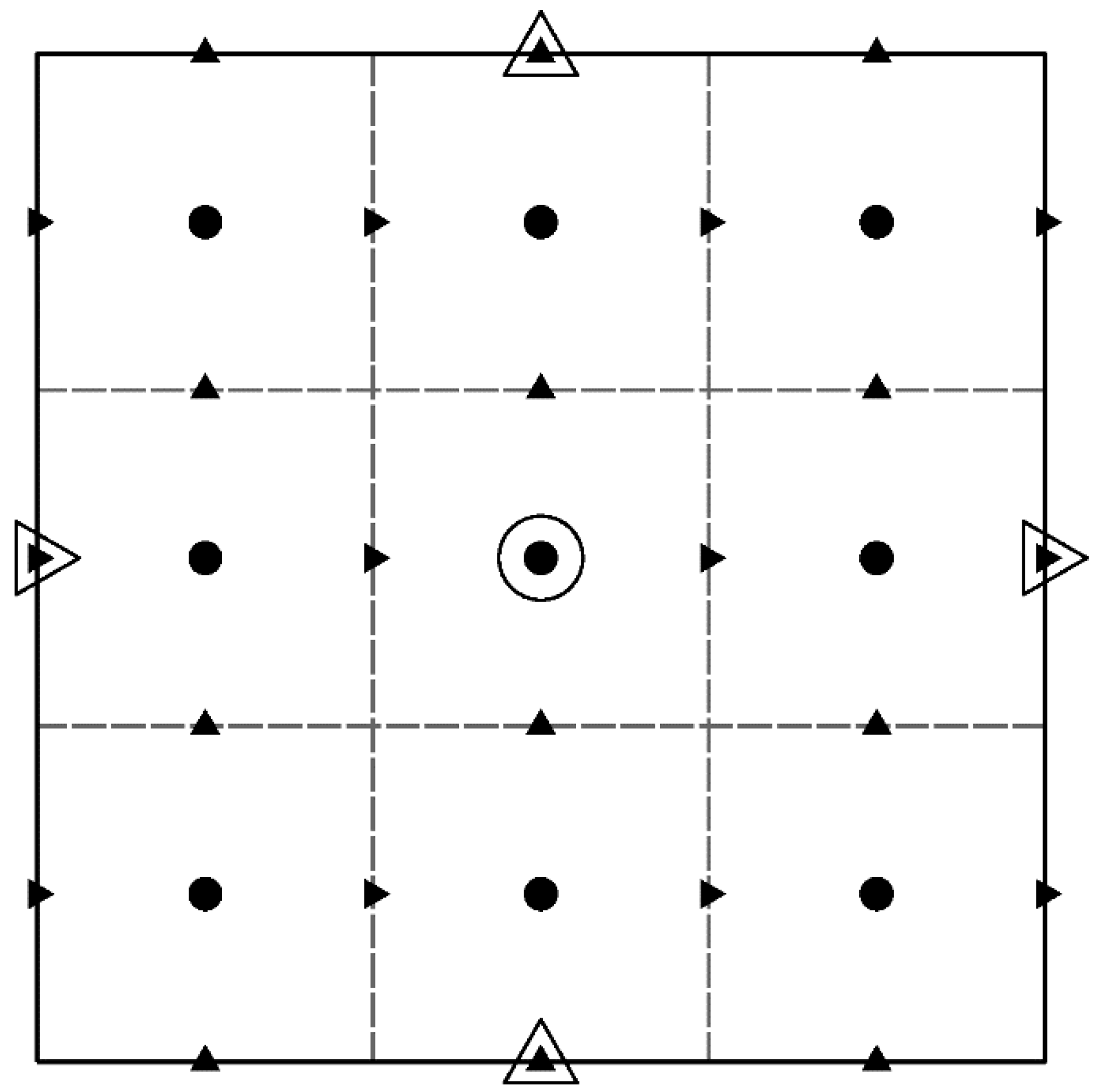
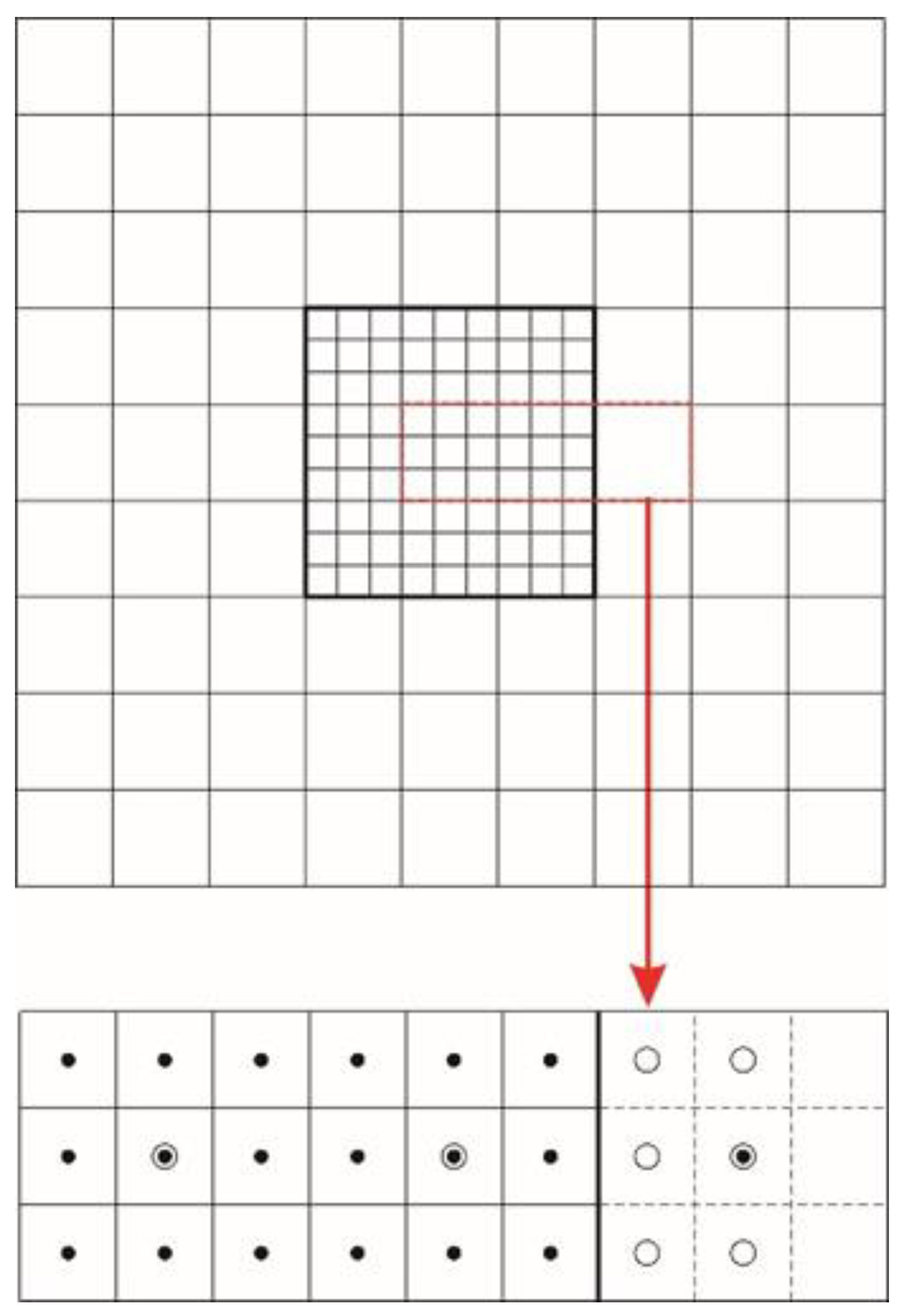
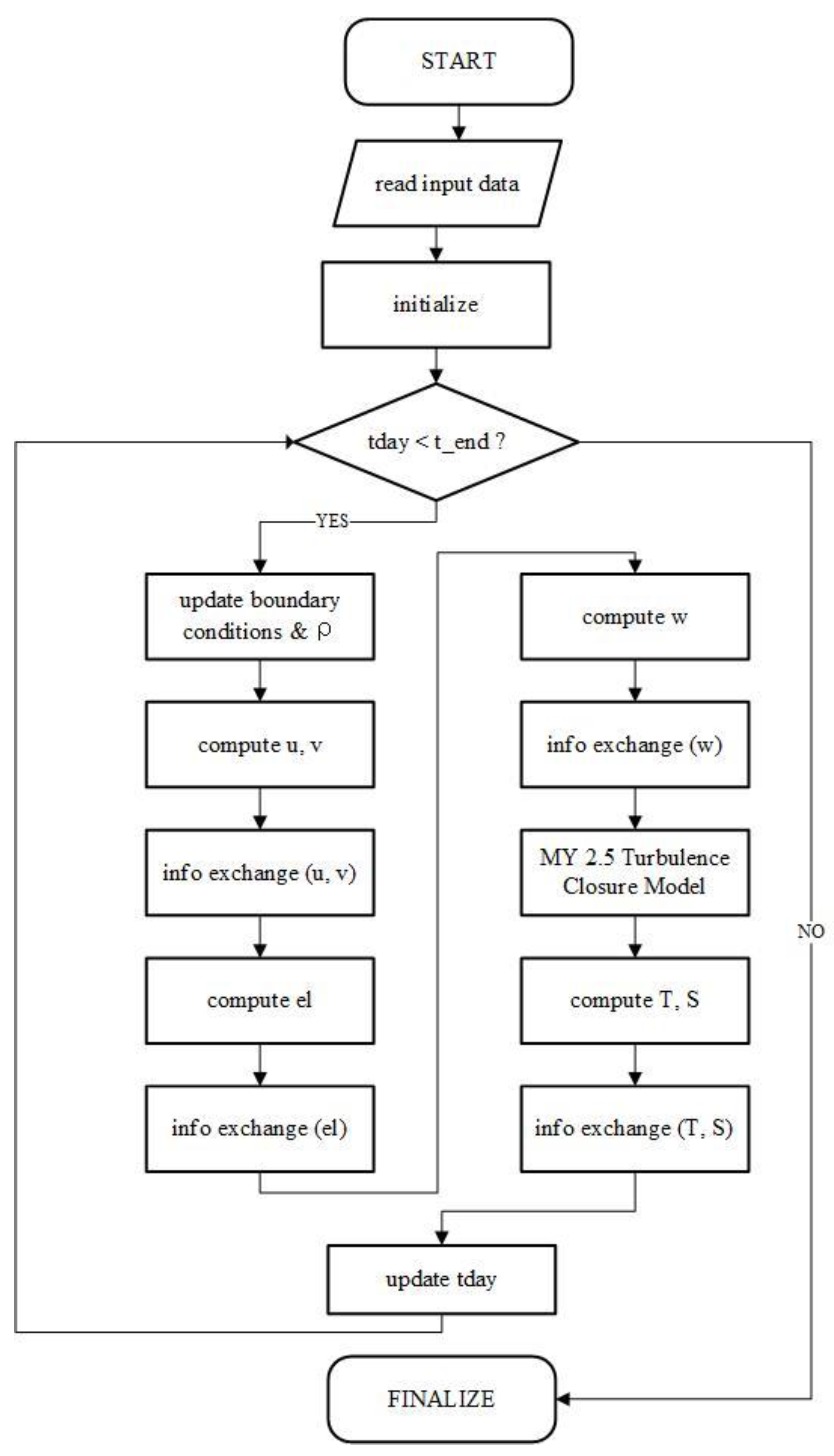
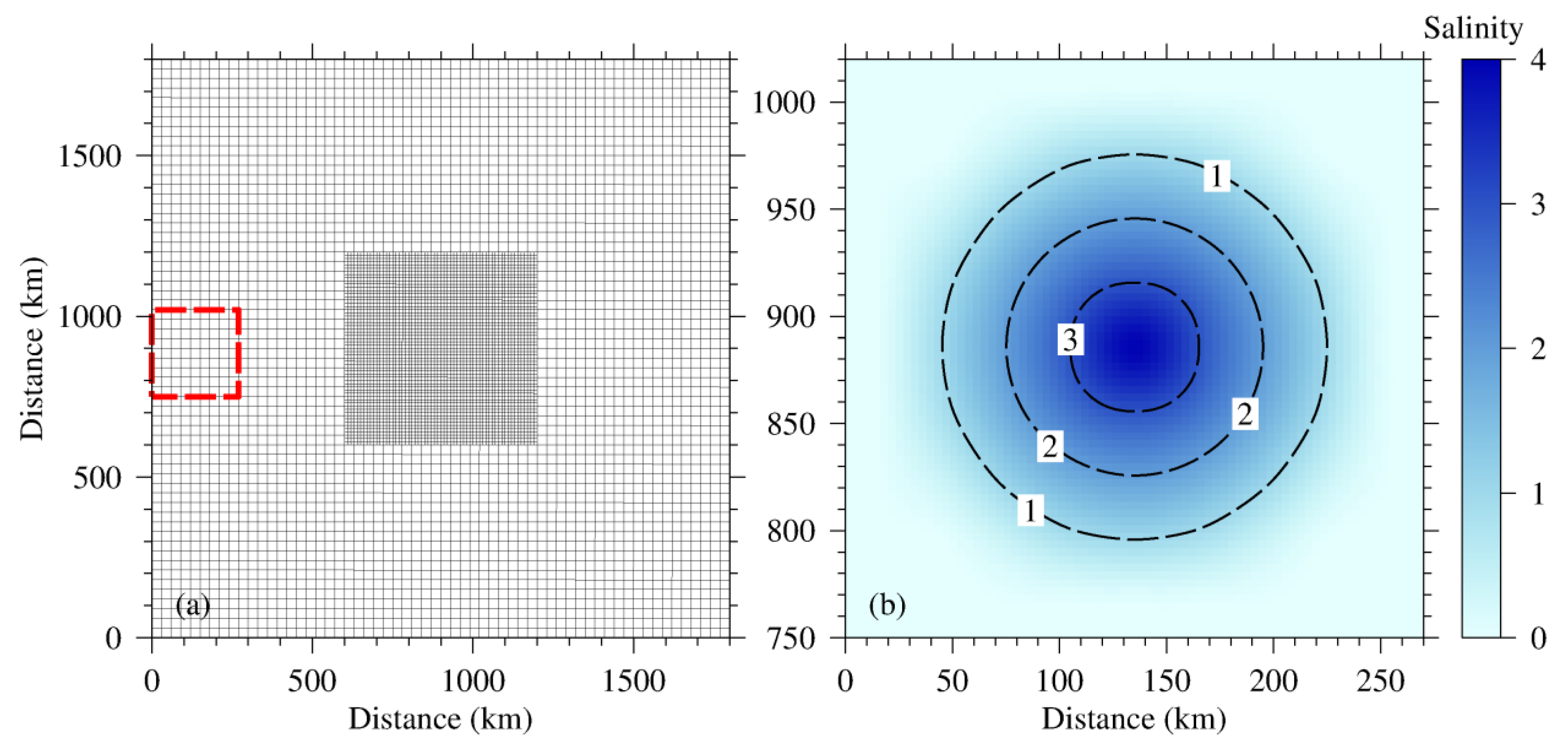

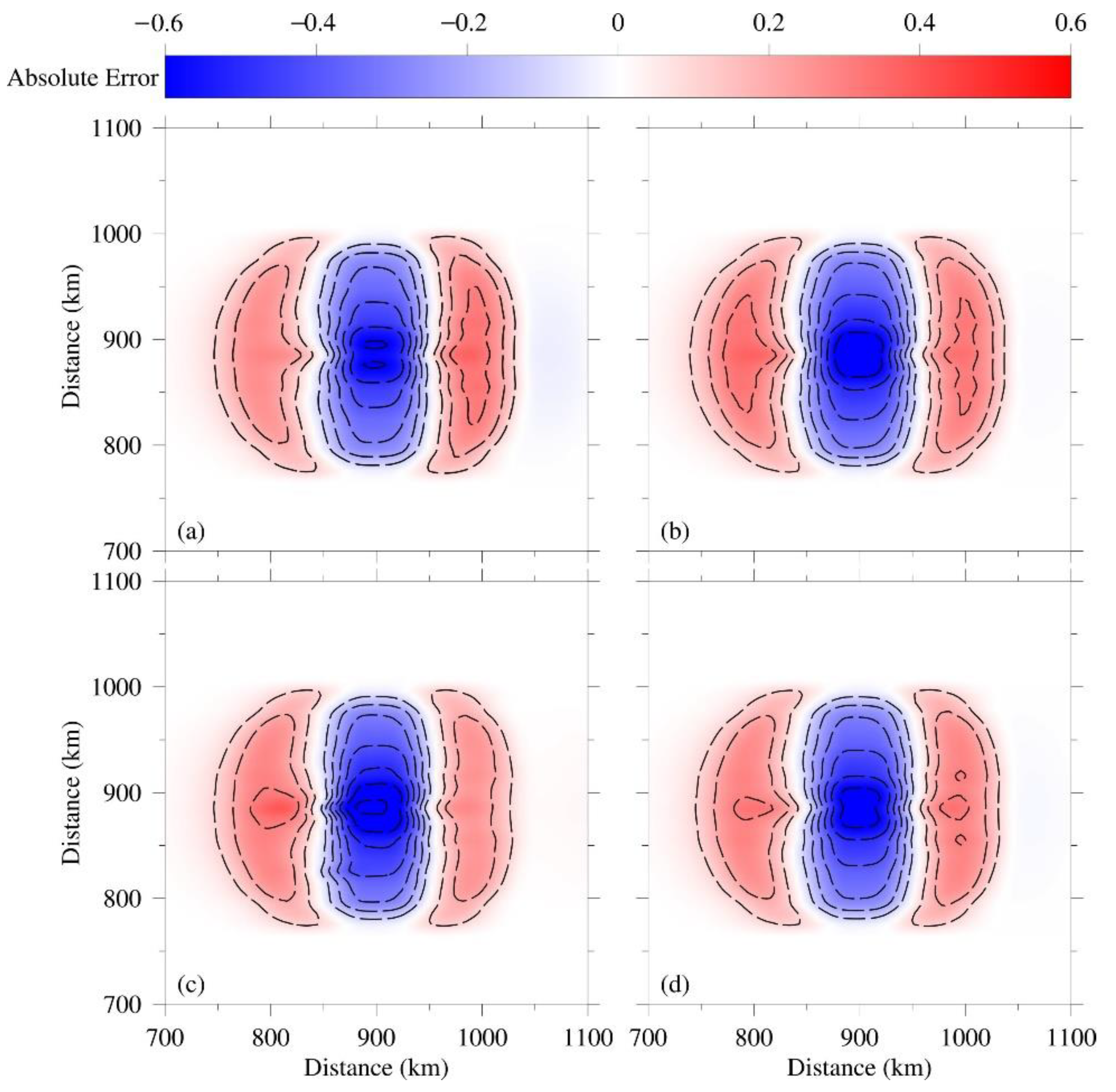
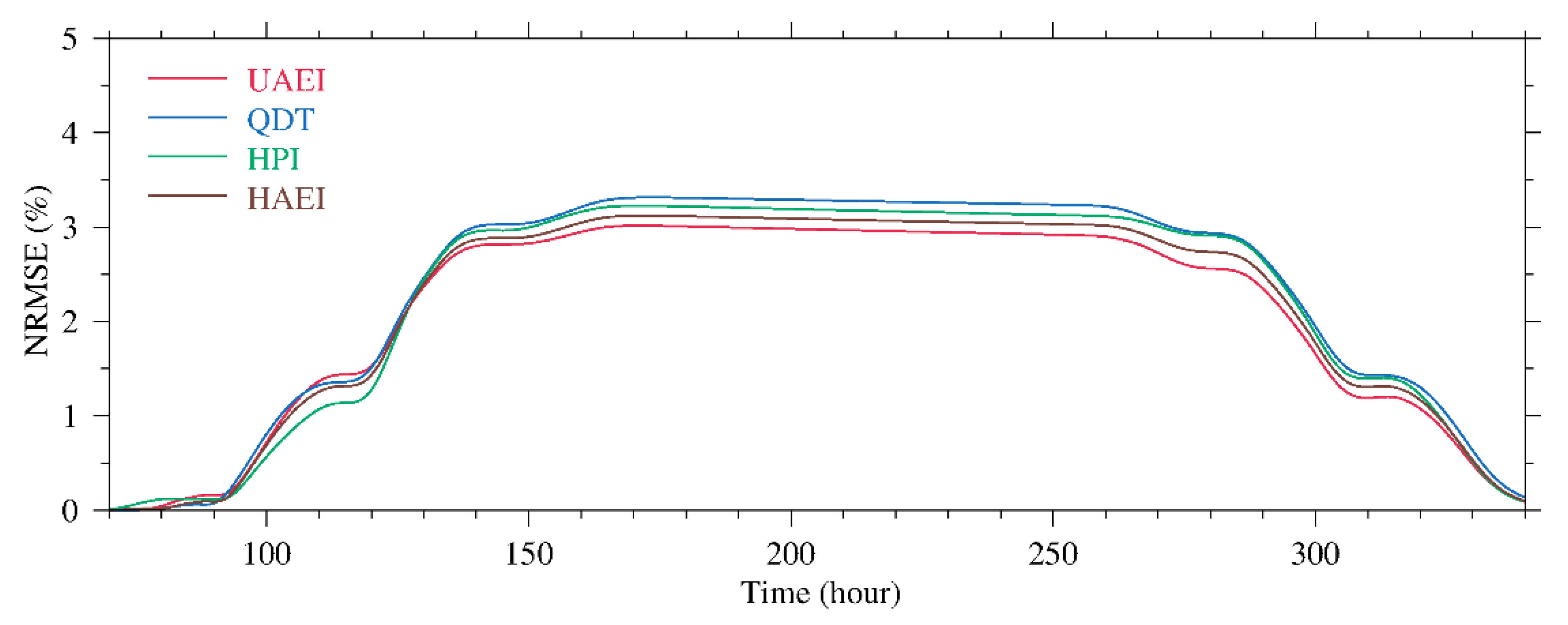
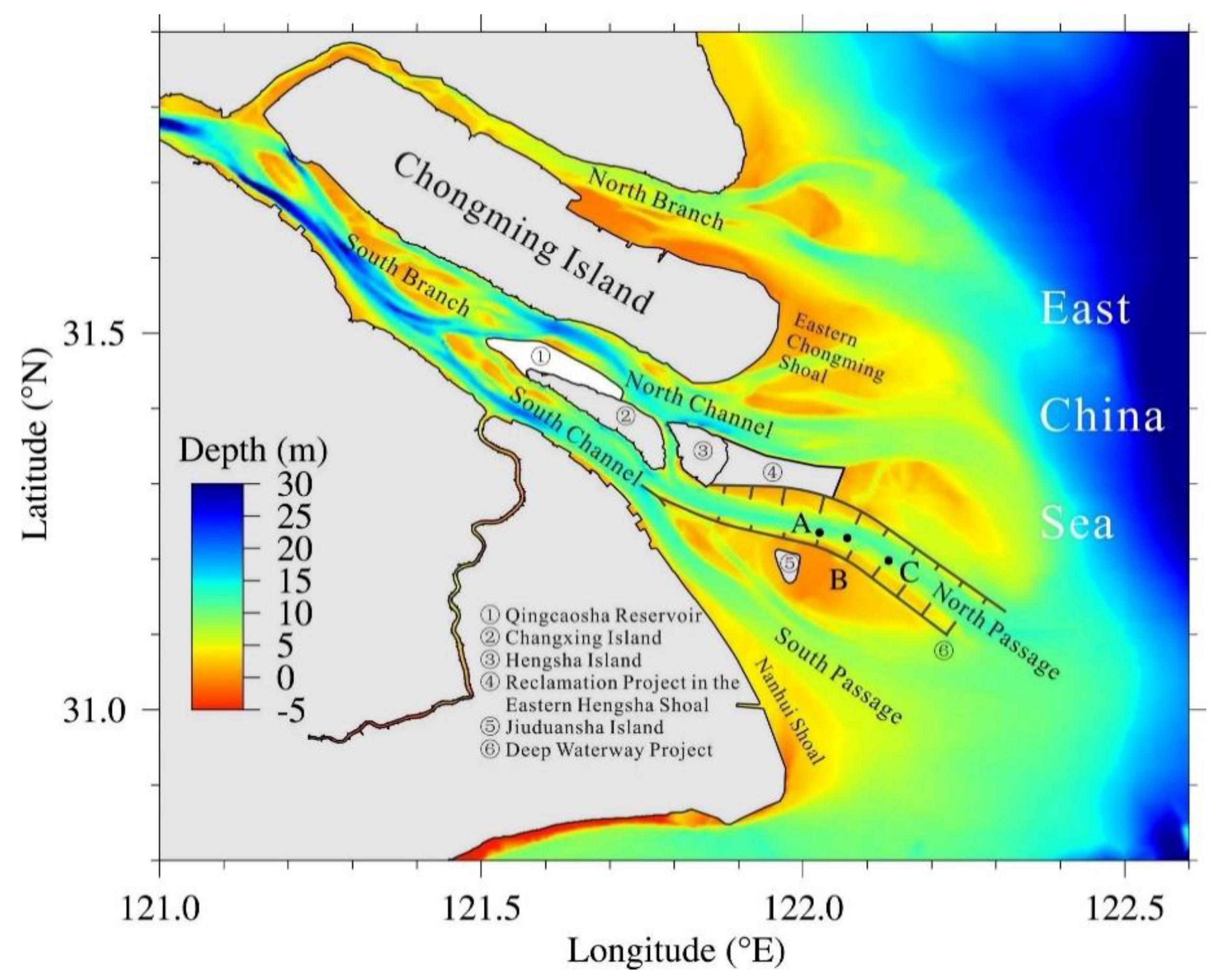
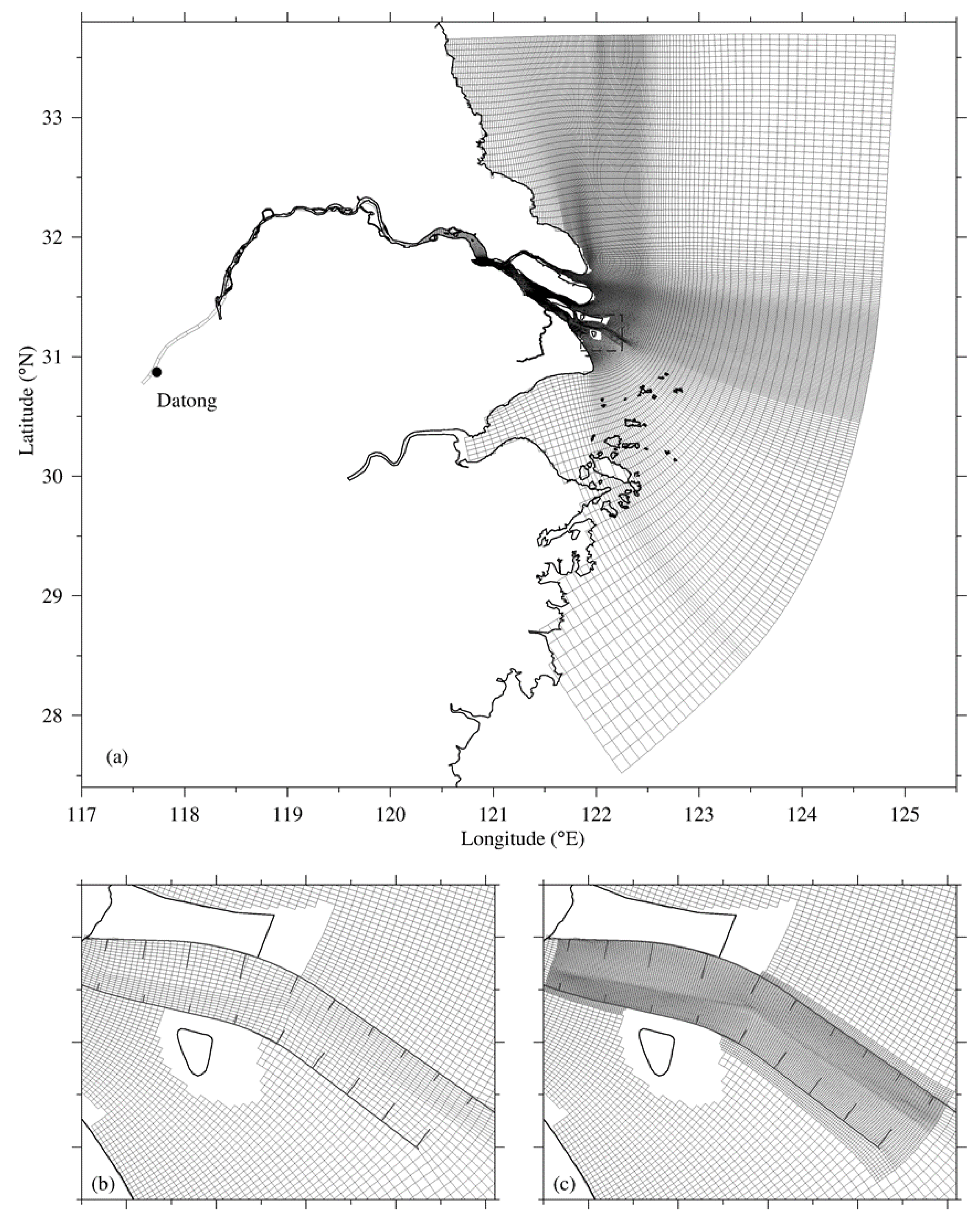
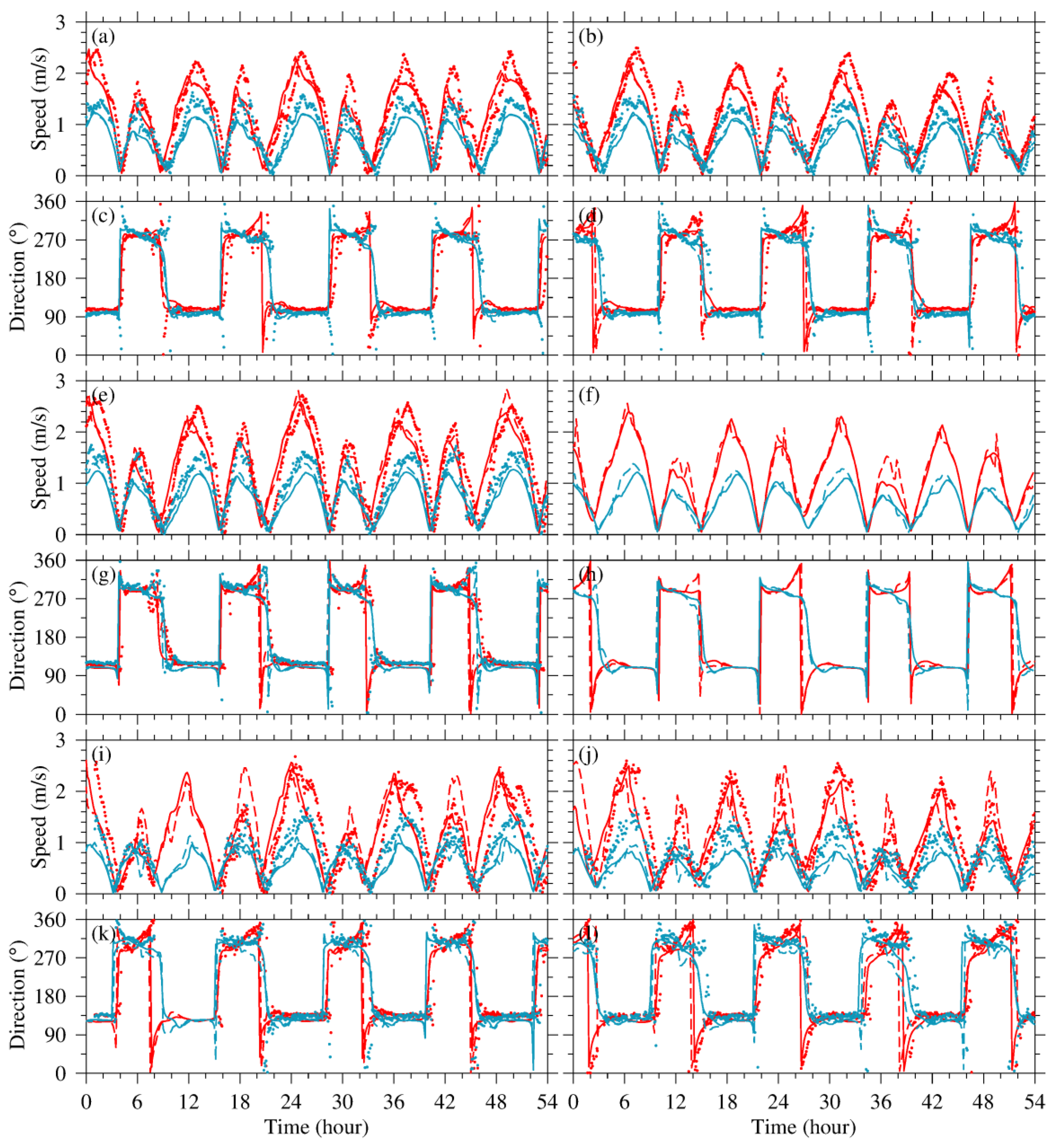
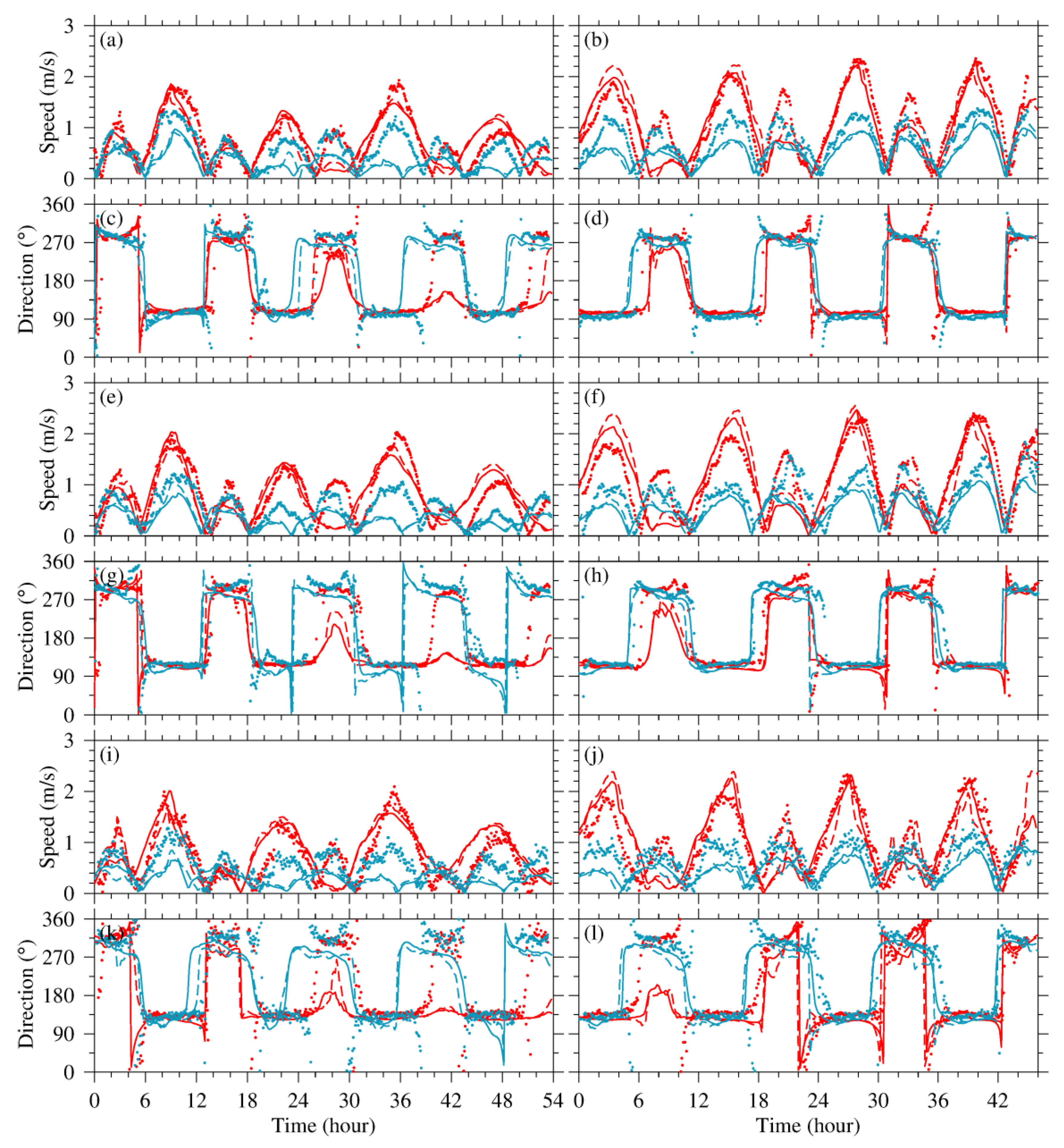
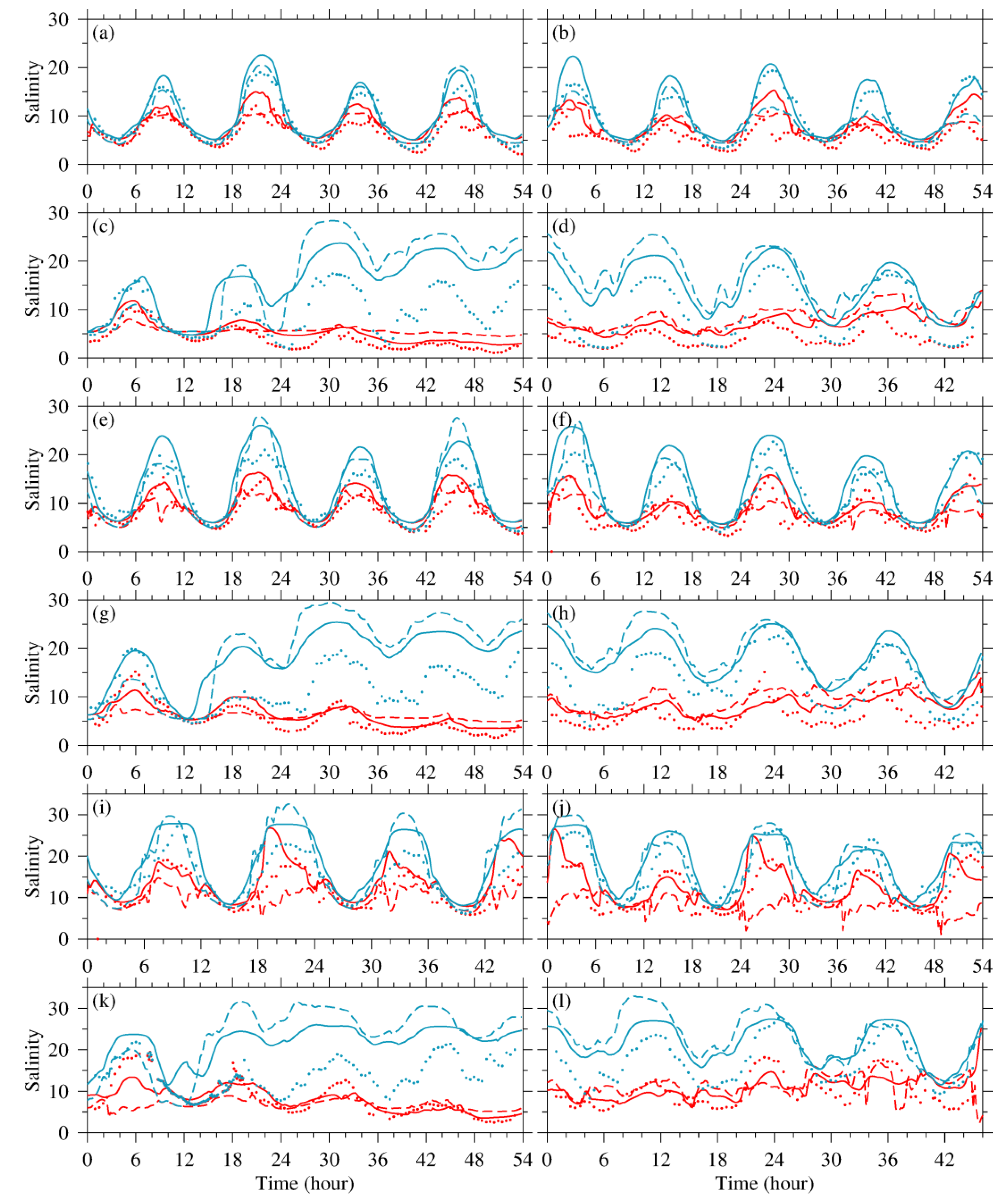
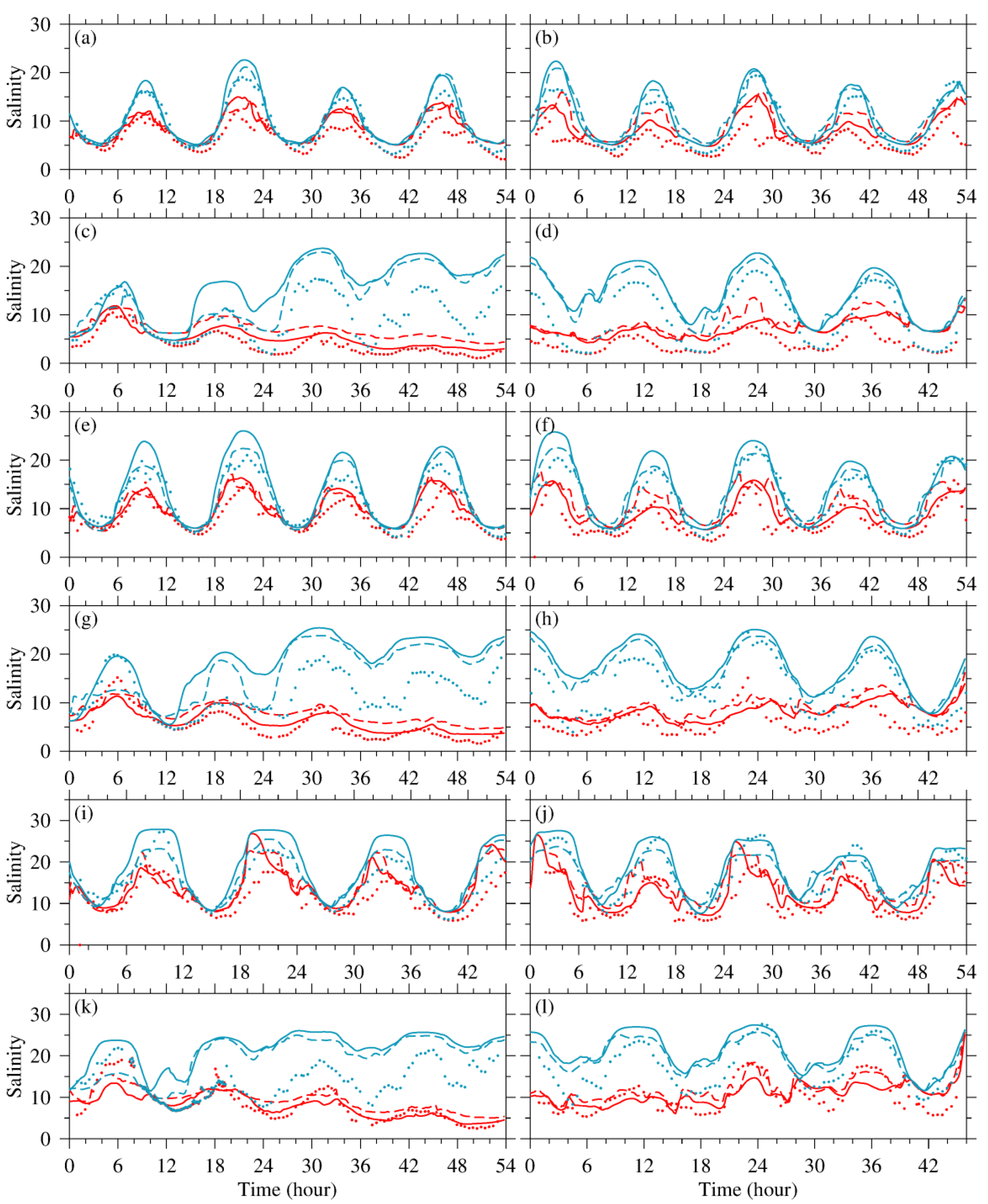
| Experiment | Interpolation Scheme |
|---|---|
| Exp. 1 | Upwind AEI |
| Exp. 2 | QI |
| Exp. 3 | HPI |
| Exp. 4 | HSIMT AEI |
| Exp. | A | B | C | ||||||
|---|---|---|---|---|---|---|---|---|---|
| CC | RMSE | SS | CC | RMSE | SS | CC | RMSE | SS | |
| Exp. 0 | 0.85/0.88 | 0.35/0.29 | 0.91/0.84 | 0.84/0.87 | 0.39/0.31 | 0.91/0.84 | 0.79/0.76 | 0.41/0.32 | 0.88/0.73 |
| Exp. 1 | 0.83/0.82 | 0.39/0.31 | 0.91/0.82 | 0.85/0.83 | 0.44/0.31 | 0.91/0.84 | 0.76/0.60 | 0.46/0.41 | 0.87/0.62 |
| Exp. 2 | 0.83/0.83 | 0.39/0.31 | 0.91/0.82 | 0.85/0.84 | 0.43/0.31 | 0.91/0.84 | 0.75/0.63 | 0.46/0.40 | 0.86/0.64 |
| Exp. 3 | 0.83/0.87 | 0.36/0.29 | 0.90/0.84 | 0.83/0.87 | 0.39/0.27 | 0.91/0.88 | 0.72/0.77 | 0.47/0.33 | 0.84/0.72 |
| Exp. 4 | 0.83/0.82 | 0.39/0.31 | 0.91/0.82 | 0.85/0.83 | 0.44/0.31 | 0.91/0.84 | 0.75/0.60 | 0.46/0.41 | 0.86/0.62 |
| Exp. | A | B | C | ||||||
|---|---|---|---|---|---|---|---|---|---|
| CC | RMSE | SS | CC | RMSE | SS | CC | RMSE | SS | |
| Exp. 0 | 0.82/0.79 | 2.68/4.94 | 0.77/0.80 | 0.82/0.82 | 2.44/5.10 | 0.85/0.82 | 0.73/0.77 | 3.21/6.03 | 0.83/0.76 |
| Exp. 1 | 0.71/0.61 | 6.25/17.23 | 0.50/0.40 | 0.63/0.66 | 6.21/17.33 | 0.56/0.41 | 0.42/0.40 | 6.16/23.08 | 0.58/0.31 |
| Exp. 2 | 0.72/0.61 | 6.03/15.97 | 0.52/0.43 | 0.65/0.66 | 6.02/15.91 | 0.57/0.43 | 0.47/0.42 | 5.90/21.04 | 0.61/0.33 |
| Exp. 3 | 0.63/0.58 | 2.84/6.53 | 0.67/0.69 | 0.54/0.62 | 2.98/6.53 | 0.69/0.72 | 0.26/0.59 | 4.48/8.20 | 0.54/0.67 |
| Exp. 4 | 0.71/0.60 | 6.10/17.23 | 0.51/0.40 | 0.61/0.66 | 6.08/17.34 | 0.56/0.41 | 0.41/0.40 | 6.03/23.21 | 0.58/0.31 |
| Exp. | A | B | C | ||||||
|---|---|---|---|---|---|---|---|---|---|
| CC | RMSE | SS | CC | RMSE | SS | CC | RMSE | SS | |
| Exp. 0 | 0.82/0.79 | 2.68/4.94 | 0.77/0.80 | 0.82/0.82 | 2.44/5.10 | 0.85/0.82 | 0.73/0.77 | 3.21/6.03 | 0.83/0.76 |
| Exp. 3 | 0.63/0.58 | 2.84/6.53 | 0.67/0.69 | 0.54/0.62 | 2.98/6.53 | 0.69/0.72 | 0.26/0.59 | 4.48/8.20 | 0.54/0.67 |
| Exp. 5 | 0.78/0.83 | 3.54/4.23 | 0.66/0.84 | 0.76/0.81 | 3.41/4.12 | 0.74/0.85 | 0.76/0.70 | 3.59/5.11 | 0.81/0.78 |
Publisher’s Note: MDPI stays neutral with regard to jurisdictional claims in published maps and institutional affiliations. |
© 2021 by the authors. Licensee MDPI, Basel, Switzerland. This article is an open access article distributed under the terms and conditions of the Creative Commons Attribution (CC BY) license (http://creativecommons.org/licenses/by/4.0/).
Share and Cite
Ding, Z.; Zhu, J.; Chen, B.; Bao, D. A Two-Way Nesting Unstructured Quadrilateral Grid, Finite-Differencing, Estuarine and Coastal Ocean Model with High-Order Interpolation Schemes. J. Mar. Sci. Eng. 2021, 9, 335. https://doi.org/10.3390/jmse9030335
Ding Z, Zhu J, Chen B, Bao D. A Two-Way Nesting Unstructured Quadrilateral Grid, Finite-Differencing, Estuarine and Coastal Ocean Model with High-Order Interpolation Schemes. Journal of Marine Science and Engineering. 2021; 9(3):335. https://doi.org/10.3390/jmse9030335
Chicago/Turabian StyleDing, Zhangliang, Jianrong Zhu, Bingrui Chen, and Daoyang Bao. 2021. "A Two-Way Nesting Unstructured Quadrilateral Grid, Finite-Differencing, Estuarine and Coastal Ocean Model with High-Order Interpolation Schemes" Journal of Marine Science and Engineering 9, no. 3: 335. https://doi.org/10.3390/jmse9030335
APA StyleDing, Z., Zhu, J., Chen, B., & Bao, D. (2021). A Two-Way Nesting Unstructured Quadrilateral Grid, Finite-Differencing, Estuarine and Coastal Ocean Model with High-Order Interpolation Schemes. Journal of Marine Science and Engineering, 9(3), 335. https://doi.org/10.3390/jmse9030335







